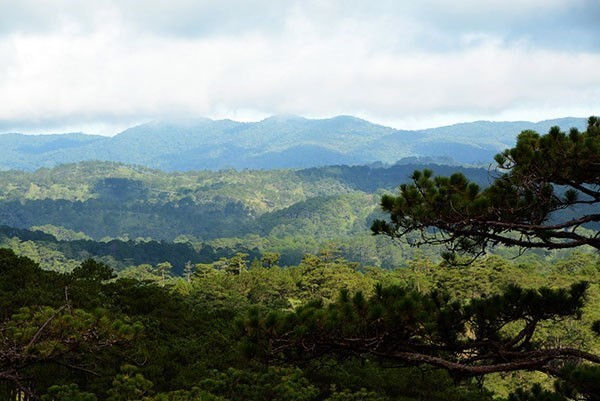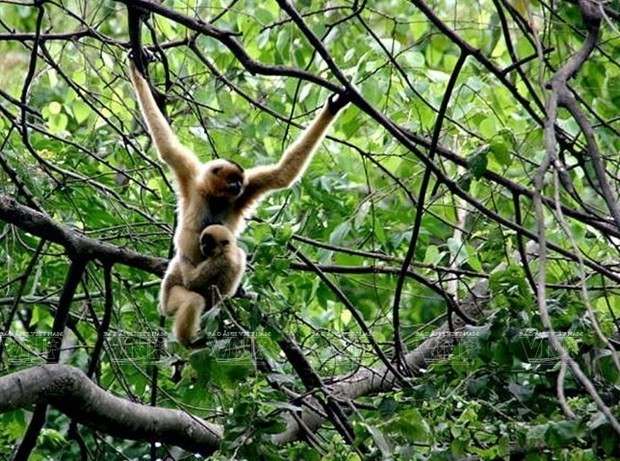
Exploring Langbiang - first biosphere reserve in Central Highlands
Latest
 |
| An overview of Langbiang - first biosphere reserve in the Central Highlands. (Photo: baolamdong.vn) |
As the 9th biosphere reserve recognised by UNESCO in Viet Nam, Langbiang is truly an attractive and special destination for nature lovers.
Biological diversity
Langbiang was recognised as a world biosphere reserve at the 27th session of the International Coordinating Council of Man and the Biosphere Programme on June 9, 2015, becoming the first of its kind in the Central Highlands.
Located in the north of Lam Dong province, it covers 275,439 hectares of land and boasts a large primeval forest whose core is the Bidoup - Nui Ba National Park. It is assessed as one of the four biodiversity centres in Viet Nam.
Located at altitudes ranging from 650 metres to 2,300 metres, Langbiang is home to a great diversity of natural ecosystems, including terrestrial and aquatic ones. It also harbours all the natural forest biotopes which are the habitat for wild animals.
The diversity of natural biotopes, from woody and bamboo mixed forest, scrubland, to grassland, has contributed to the richness of reptile, amphibian, insect, and flora species.
Meanwhile, aquatic biotopes such as lakes, rivers, and streams in the middle of a forest not only form beautiful landscapes, but create transitions of ecosystems, and act as the habitat of fish and other aquatic species.
Thanks to its ecosystem diversity, the Langbiang Biosphere Reserve is home to 1,940 flora species, including particularly rare ones like “thong hai la det” (Pinus krempfii), which is endemic to the Bidoup - Nui Ba National Park; “po mu” (Fokienia hodginsii (Dunn) A. Henry et Thomas), “thong do” (Taxus Wallichiana Zucc), and “thong 5 la Da Lat” (Pinus dalatensis).
With 297 orchid species, Langbiang is dubbed the “orchid capital” of Viet Nam. As many as 89 mammal species, 247 bird species, 46 reptile species, 30 fish species, and 335 insect species have also been reported here.
The biosphere reserve holds biodiversity values of global importance. Scientists recorded 153 fauna and flora species listed in the 2007 Vietnam Red Data Book and 154 in the 2010 International Union for Conservation of Nature (IUCN) Red List.
 |
| An endemic gibbon species in the Langbiang Biosphere Reserve. (Photo: VNA) |
Among them, five face the risk of global extinction, namely the Indochinese tiger (Panthera tigris corbetti), black-shanked douc (Pygathrix nigripes), yellow-cheeked gibbon (Nomascus gabriellae), gaur (Bos gaurus), and Annamese langur (Trachypithecus margarita).
The World Wide Fund for Nature (WWF) also identified this place as the No 1 priority area for conservation in a programme on conserving the main mountains of the South Truong Son Mountain Range in Viet Nam.
In addition, the Langbiang Biosphere Reserve also harbours the space of gong culture in the Central Highlands, which was listed as a “Masterpiece of the Oral and Intangible Cultural Heritage of Humanity” by UNESCO.
The space of gong culture spreads across the five Central Highlands provinces of Kon Tum, Gia Lai, Dak Lak, Dak Nong, and Lam Dong, with its owners being local ethnic groups such as Bana, Xedang, Mnong, K’ho, Romam, Ede, Giarai.
Efforts made for conservation and sustainable development
According to Lam Dong authorities, the UNESCO recognition of Langbiang as a world biosphere reserve has created both opportunities and challenges to the province in general and the Vietnamese Government in particular, in maintaining the functions of a world-class biosphere reserve.
Relevant agencies have the responsibility for seriously realising the international commitment to biodiversity conservation. To do that, they will have to seek more concerted, scientific, and thorough measures to adapt to climate change.
Besides, it is also necessary to have more scientific solutions to achieve sustainable development on the basis of the economic, social, and environmental pillars.
To manage and protect the first world biosphere reserve in the Central Highlands, Lam Dong province set up a management board for the site, increased communications, conducted scientific research and biodiversity conservation, and enhanced cooperation with international partners.
The management board has given priority to ensuring the harmony between humans and nature, upholding traditional cultural identities of the ethnic groups residing in the reserve, and guaranteeing the concurrence of human and social development and biodiversity conservation.













